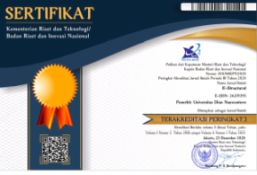Focus and Scope
E-Structural (English Studies on Translation, Culture, Literature, and Linguistics) is committed to publishing studies in the areas of English linguistics, literature, translation, and culture. E-Structural (English Studies on Translation, Culture, Literature, and Linguistics) is published twice a year, in June and December. The articles published in E-Structural (English Studies on Translation, Culture, Literature, and Linguistics) undergo a peer-review process by local and international reviewers. E-Structural (English Studies on Translation, Culture, Literature, and Linguistics) accommodates current research on the English language and provides a discussion forum for researchers especially in Indonesia.
Section Policies
Articles
Peer Review Process
E-Structural (English Studies on Translation, Culture, Literature, and Linguistics) aims to publish academic articles that uncover new depths in the study of translation, culture, literature, and linguistics. These articles should be able to contribute to and advance our current understanding of translation, culture, literature, and linguistics, with a sound scientific basis. To ensure this, we use double-blind review, which means that both the reviewer and author identities are concealed from the reviewers, and vice versa, throughout the review process.
More specifically, our editorial process consists of the following steps:
- Initial screening. All submissions are initially screened by the Editor-in-Chief for their conformity to E-Structural (English Studies on Translation, Culture, Literature, and Linguistics)'s scope and basic submission requirements, and checked for plagiarism. Manuscripts that fail to abide by our ethical standards are immediately rejected, as are manuscripts that do not fit within the journal's scope.
- Reviewer assignment. Manuscripts that passed the initial screening are then handed over to a section editor, who will select at least two relevant reviewers and initiate the peer review process for double-blind review.
- Peer review. During this stage, a reviewer will assess the content of the manuscript and provide their recommendation to the Editor-in-Chief.
- First decision. Once both (or more) reviewers have submitted their recommendations, the manuscript is either rejected, asked for revisions (minor or major), or accepted as is. If it is accepted, the manuscript is returned to the submitting author for proofreading. The final decision to accept the manuscript is made by the Editor-in-Chief based on the recommendation of the section editor and following approval by the editorial board.
- Revision. A manuscript that requires revisions is returned to the submitting author, who will have up to one week to revise the manuscript. Once the revision is submitted, it is once again assessed by the section editor to determine whether the changes are adequate and appropriate, as well as whether the author(s) sufficiently responded to the reviewers' comments and suggestions. If the revisions are deemed to be inadequate, this step is repeated (the manuscript is returned to the submitting author once more for further revision).
- Final decision. Finally, the revised manuscript is either accepted or rejected, depending on whether the section editor has found the manuscript to have been improved to a level worthy of publication. If the author(s) are unable to make the required changes or have done so to a degree below E-Structural (English Studies on Translation, Culture, Literature, and Linguistics)'s standards, the manuscript is rejected.
- Language editing. Once the manuscript is accepted, it is returned to the submitting author for the final editing of its language and content; these are changes that improve the readability of the article without changing the substance of the content. E-Structural (English Studies on Translation, Culture, Literature, and Linguistics) requires authors to return the manuscript with proof that changes have been made, which the editorial board will review before ultimately greenlighting the manuscript for publication.
- Typesetting. Once greenlit, the manuscript is handed over to the journal's typesetter. The final version of the article, as it will appear in E-Structural (English Studies on Translation, Culture, Literature, and Linguistics), is returned to the submitting author for proofreading and final approval.
- Publication. Congratulations! The published article will appear in the latest issue of E-Structural (English Studies on Translation, Culture, Literature, and Linguistics).
Open Access Policy
This journal provides immediate open access to its content on the principle that making research freely available to the public supports a greater global exchange of knowledge.


























